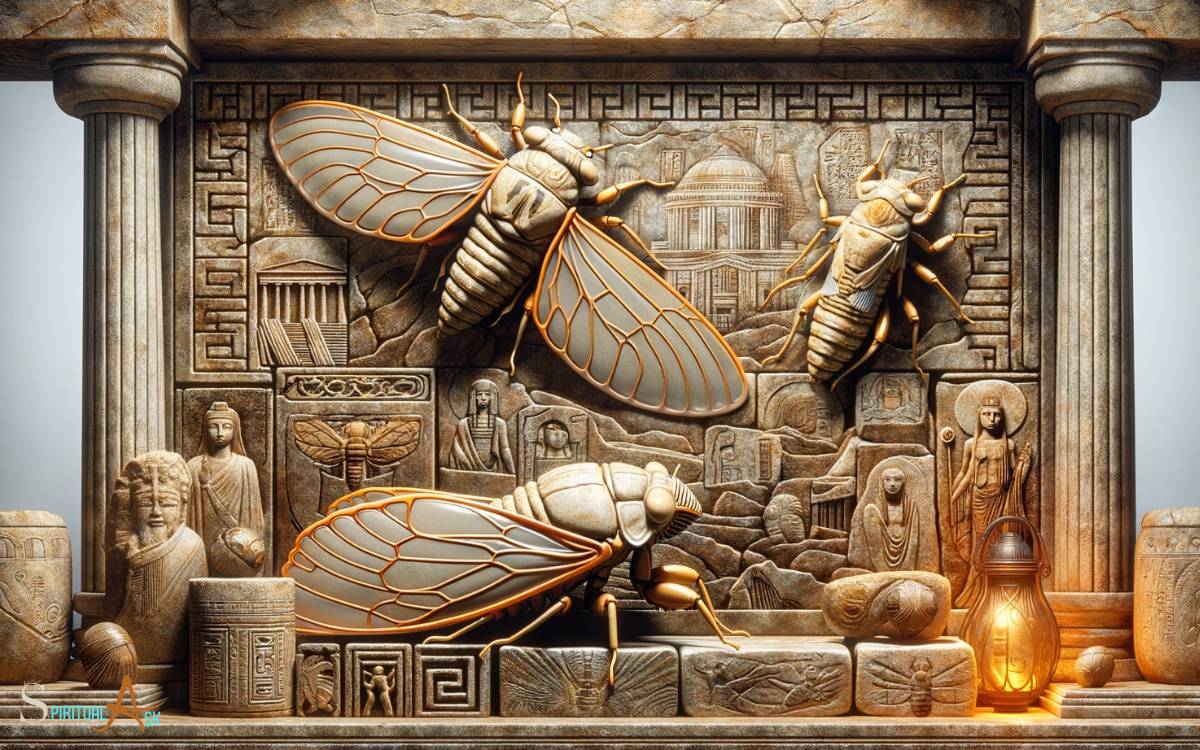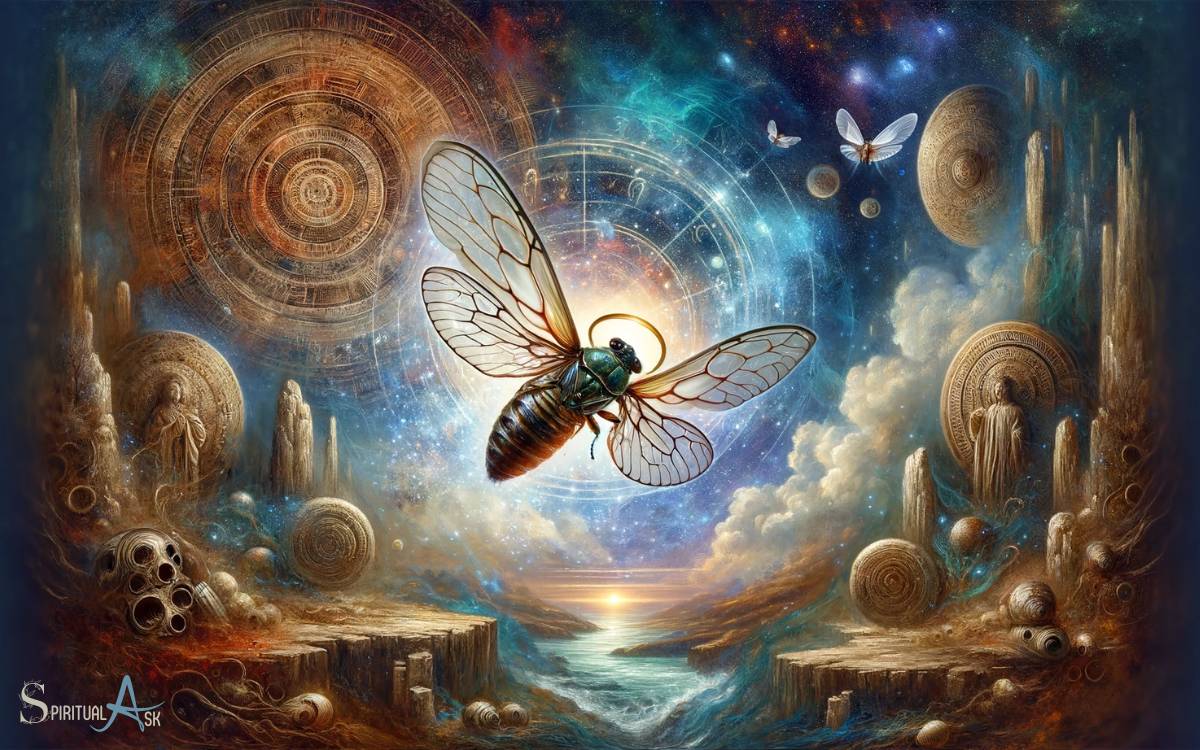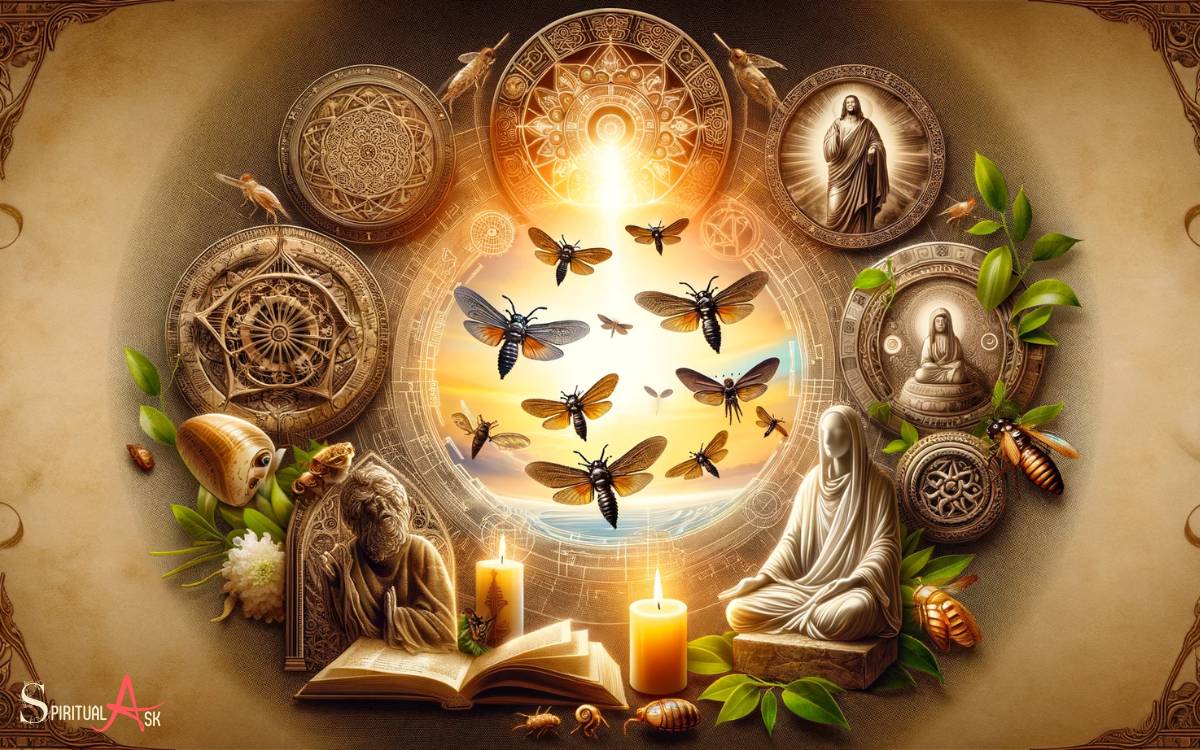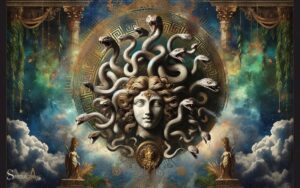What Do Cicadas Symbolize Spiritually? Immortality!
Cicadas are often seen as symbols of immortality, resurrection, transformation, and spiritual awakening due to their unique life cycle and loud, distinctive song.
In various cultural and spiritual traditions, cicadas carry deep symbolic meanings:
As an example, in ancient China, cicadas were often used as talismans for immortality and eternal youth.
The cicada’s emergence after years underground inspires awe and a sense of wonder, serving as a powerful emblem of life’s mysteries and the cycles of nature.

Key Takeaway
Historical Significance in Ancient Cultures

Rarely do ancient cultures not have some form of symbolism or significance assigned to the cicada.
In many ancient societies, the cicada was seen as a symbol of resurrection and immortality due to its remarkable life cycle.
The Greeks and Romans, for instance, associated the cicada with the afterlife and used its image in art and jewelry.
The insect’s ability to lie dormant underground for many years before emerging into the sunlight was often likened to the human soul’s journey.
In China, the cicada was a symbol of rebirth and transformation. Its association with long life and happiness made it a popular decorative motif, particularly in jade sculptures and other artifacts.
Across various cultures, the cicada’s presence in folklore and art underscores its enduring significance in spiritual and symbolic contexts.
Representations of Rebirth and Transformation

In exploring the representations of rebirth and transformation, the cicada’s symbolism in various cultures reflects enduring themes of renewal and change.
The cicada’s life cycle, spent underground for years before emerging, symbolizes the idea of rebirth and transformation.
- In Chinese culture, the cicada’s molting process represents immortality and transformation.
- The ancient Greeks also viewed the cicada as a symbol of resurrection and immortality due to its remarkable life cycle.
- Similarly, in Native American cultures, the cicada’s emergence from the ground is seen as a symbol of rebirth and transformation.
These representations of the cicada’s symbolism highlight the universal significance of renewal and change in various spiritual and cultural contexts.
Connection to Immortality and Resurrection
The cicada’s connection to immortality and resurrection is evident in various cultural and spiritual beliefs, highlighting its enduring significance.

In many cultures, the cicada is seen as a symbol of immortality and resurrection due to its remarkable life cycle.
This insect spends years underground before emerging, shedding its exoskeleton, and transforming into its adult form.
This transformation from a seemingly lifeless shell to a vibrant creature mirrors the concept of resurrection and the eternal cycle of life and death.
Immortality and Resurrection
- Symbol of rebirth and renewal
- Representation of eternal life
- Signifies the cyclical nature of existence
- Connection to life after death
This deep symbolism surrounding the cicada’s life cycle fosters a profound sense of awe and reverence, underscoring its spiritual significance. In many cultures, the cicada is seen as a symbol of resurrection and immortality, with its long underground hibernation representing death and its emergence and metamorphosis symbolizing rebirth and new life. This symbolism is further amplified when considering the cicada’s association with the symbolism of buffalo, which is often linked to abundance, strength, and the sacredness of life. The interconnectedness of these symbols serves to deepen the spiritual and cultural significance of the cicada in various traditions and belief systems.
The belief in the cicada’s association with immortality and resurrection is embedded in various traditions and continues to resonate deeply with many individuals.
Symbolism in Different Religious Beliefs

The cicada’s connection to immortality and resurrection extends into different religious beliefs, deepening its spiritual significance and symbolism.
- In Christianity, the cicada’s emergence from the ground after years of dormancy can symbolize the resurrection of Jesus Christ and the hope of eternal life.
- In Buddhism, the cicada is associated with immortality and spiritual realization, as it undergoes numerous transformations and represents the cycle of birth, death, and rebirth.
- Hinduism views the cicada as a symbol of renewal and transformation, reflecting the idea of cyclical time and the eternal nature of the soul.
Across various religious beliefs, the cicada serves as a powerful symbol of transcendence, renewal, and the enduring nature of the soul.
Modern Interpretations and Spiritual Relevance

Growing up in a diverse and interconnected world, my understanding of the spiritual relevance of cicadas has been shaped by modern interpretations and cultural influences.
In today’s society, many people view cicadas as symbols of transformation, rebirth, and immortality.
This perspective aligns with the insect’s remarkable life cycle, spending years underground before emerging to molt and fly.
Additionally, in modern interpretations, the loud buzzing sound produced by male cicadas is seen as a call to awaken, reminding us to listen to our inner voice and embrace change.
The table below summarizes some modern interpretations of the spiritual relevance of cicadas.
| Modern Interpretations of Cicadas | Spiritual Relevance |
|---|---|
| Transformation and rebirth | Symbolizes change and renewal in life |
| Immortality | Represents the eternal nature of the soul |
| Awakening call | Encourages listening to inner wisdom |
| Patience and perseverance | Signifies endurance and resilience |
| Connection to nature | Emphasizes harmony with the natural world |
Conclusion
As I sat pondering the spiritual symbolism of cicadas, a gentle humming filled the air. I looked out the window to find a cicada perched on the sill, its wings shimmering in the sunlight. It felt like a sign, a reminder of the cyclical nature of life and the promise of transformation.
In that moment, I couldn’t help but feel a deep sense of connection to the spiritual significance of these fascinating creatures.






